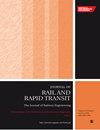Cavity noise reduction of a high-speed train pantograph through jet parameter optimization
IF 2.1
4区 工程技术
Q3 ENGINEERING, CIVIL
Proceedings of the Institution of Mechanical Engineers Part F-Journal of Rail and Rapid Transit
Pub Date : 2024-05-06
DOI:10.1177/09544097241251912
引用次数: 0
Abstract
The effect of aerodynamic noise from high-speed trains on residents living near railway lines is a critical issue. The pantograph cavity is considered to be a major source of aerodynamic noise. To address this problem, this study proposes the application of jetting at the leading edge of the cavity, directly targeting noise reduction at its source. The large eddy simulation approach is used for flow calculations, and the Ffowcs Williams and Hawkings aeroacoustic analogy is adopted for far-field acoustic predictions. Orthogonal designs and the backpropagation algorithm optimized by the genetic algorithm (BP-GA) is used to explore the effects of jetting factors on noise and identify the optimal parameters. Orthogonal design analysis shows that the most influential among the factors is jet orifice diameter, followed by jet velocity and jet angle. The use of the BP-GA algorithm for optimization reveals that the optimal jet parameters are jet velocity of 118.28 m/s, jet angle of 3.17°, and jet orifice diameter of 76.74 mm. The algorithm predicts a minimum noise level of 91.04 dB, which is close to the simulated noise level of 90.74 dB. The jetting process achieves a maximum noise reduction of 4 dB. Results demonstrate that the proposed method for cavity leading edge jetting effectively reduces turbulent kinetic energy and horseshoe-shaped vortices in the cavity, leading to noise reduction. This method also minimizes the effects of aerodynamic noise on distant areas, such as waiting areas and residential buildings. This work provides a theoretical basis for increasing high-speed train speeds.通过喷射参数优化降低高速列车受电弓的空腔噪音
高速列车的空气动力噪声对铁路线附近居民的影响是一个关键问题。受电弓空腔被认为是空气动力噪声的主要来源。为解决这一问题,本研究提出在空腔前缘应用喷射技术,直接从噪音源头降低噪音。流动计算采用大涡模拟方法,远场声学预测采用 Ffowcs Williams 和 Hawkings 航空声学类比方法。采用正交设计和遗传算法优化的反向传播算法(BP-GA)来探索喷射因素对噪声的影响,并确定最佳参数。正交设计分析表明,影响最大的因素是喷射孔直径,其次是喷射速度和喷射角度。使用 BP-GA 算法进行优化后发现,最佳喷射参数为喷射速度 118.28 米/秒、喷射角度 3.17°、喷射孔直径 76.74 毫米。该算法预测的最低噪音水平为 91.04 dB,接近模拟噪音水平 90.74 dB。喷射过程的最大噪音降低了 4 分贝。结果表明,所提出的空腔前缘喷射方法能有效减少空腔中的湍流动能和马蹄形涡流,从而降低噪声。这种方法还能将空气动力噪声对远处区域(如等候区和住宅楼)的影响降至最低。这项工作为提高高速列车速度提供了理论依据。
本文章由计算机程序翻译,如有差异,请以英文原文为准。
求助全文
约1分钟内获得全文
求助全文
来源期刊

CiteScore
4.80
自引率
10.00%
发文量
91
审稿时长
7 months
期刊介绍:
The Journal of Rail and Rapid Transit is devoted to engineering in its widest interpretation applicable to rail and rapid transit. The Journal aims to promote sharing of technical knowledge, ideas and experience between engineers and researchers working in the railway field.
 求助内容:
求助内容: 应助结果提醒方式:
应助结果提醒方式:


